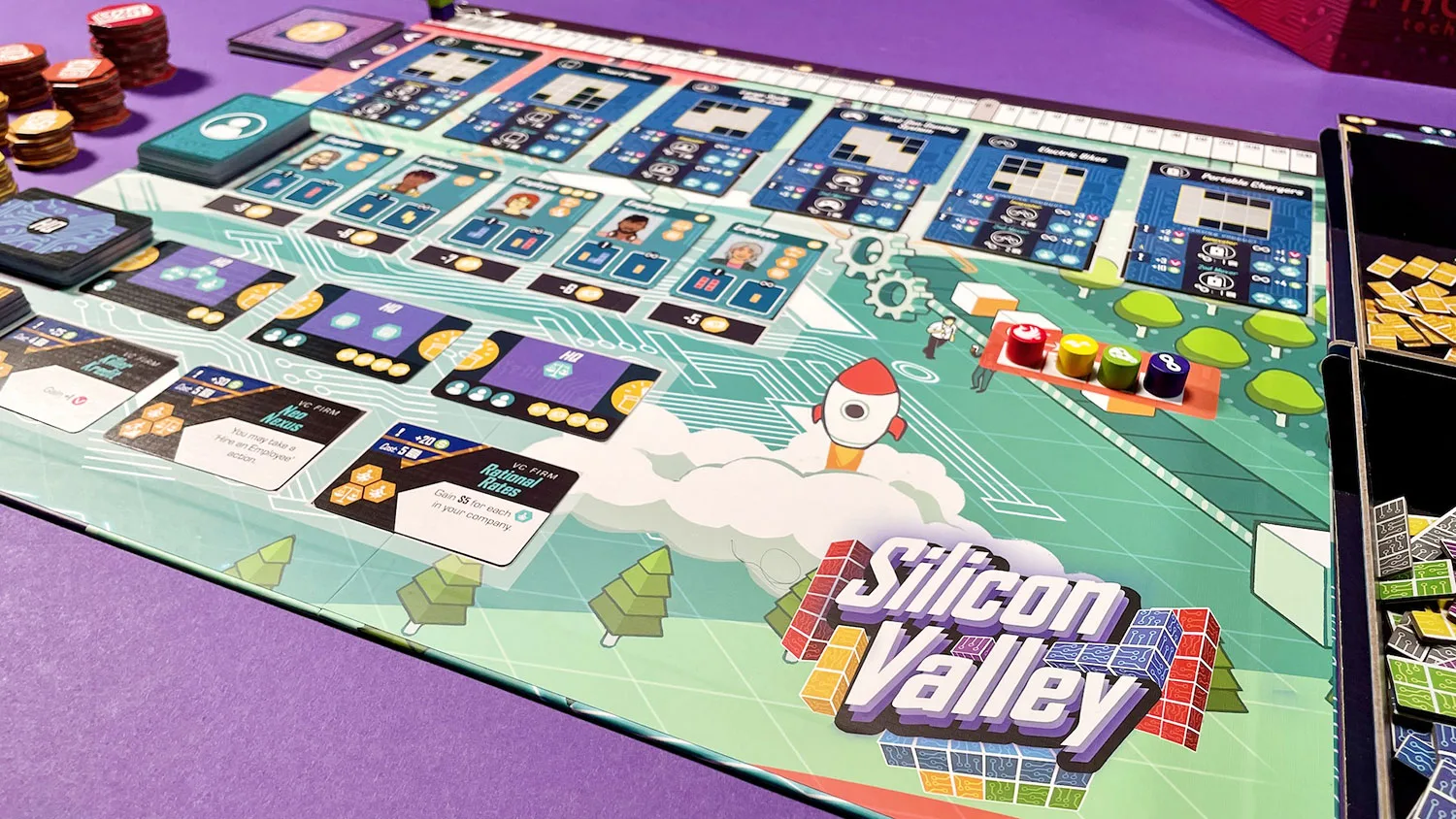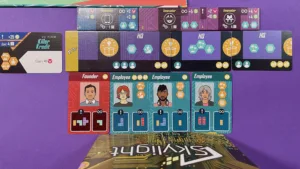![]() As a San Francisco Bay Area resident, I’m generally the first BGQ Staff member to jump on Silicon Valley-themed games. When a copy of this one came up, I waved my digital arms wildly for it. Tech culture may not be what it used to be these days with the continuing layoffs and economic uncertainty, but startups and their relationships with venture capitalists are still going strong.
As a San Francisco Bay Area resident, I’m generally the first BGQ Staff member to jump on Silicon Valley-themed games. When a copy of this one came up, I waved my digital arms wildly for it. Tech culture may not be what it used to be these days with the continuing layoffs and economic uncertainty, but startups and their relationships with venture capitalists are still going strong.
Silicon Valley is a tile placement and economic game for 1-4 players that takes about an hour to play. The best experience is with 4 players for a more competitive and frantic atmosphere.
Gameplay Overview:
The game takes place over a series of rounds, and each game round has two phases: Companies take 3 actions and Companies operate.
The actions available to Companies are: Hire an employee, Poach an Employee, Expand HQ, Acquire VC Funding, Outsource, Launch a Product, Sunset a Product, and Perform Layoffs. When Companies operate, players collect ongoing benefits from all parts of their company, pay upkeep, and check valuation.

Silicon Valley’s main gameplay feature is collecting code polyomino blocks through their startup founders, employees, and outsourcing to qualify for product launches. Those first to launch a specific product are designated as Innovators, while the second player to match the Innovator’s block pattern becomes a 2nd Mover. Both come with various instant and ongoing benefits like money and/or valuation. You then populate the game board with new advanced products as the cycle of Innovators and 2nd Movers continues for each idea.
If one or more players have a company with a $1 Billion valuation or more, the game ends and the player with the highest valuation is the winner. Ties are broken by having the most money, then the most code, and finally ties that remain after this share the victory.

Game Experience:
I tend to be critical of games that have a loaded theme like “Silicon Valley” but this one seamlessly integrated its theme with the player actions. I’ve worked in startup environments for most of my career and can confirm that many of the themed actions available to players in this game are accurate. From the increasing overhead from HQ expansions, to the employee’s company culture needs, and even making products in a quick and dirty manner, it’s clear that the designer and playtesters honed in on something great.

Given the polyomino product launches were the focus for gaining valuation and thus racing to win the game, I found that it was an engaging brain teaser and easy to understand as the main goal. Sometimes in games of medium weight it can be unclear what the best path forward to victory is but in this game even reading through the rules you can tell what it wants players to do. There isn’t much of an effect where only one or two players at the table think far enough ahead to see where the real points lie, which evens out the playing field for everyone.
While most of the actions during the first phase of the game were useful, we found that poaching an employee and performing layoffs were not necessary. I have a feeling they were included for flavor, but most players at the table were cognizant of each action they took to grow their companies. If you are planning ahead and not growing for its own sake, there arguably should be no need to choose either of those actions as poaching an employee is very expensive. Performing layoffs may mean that you were forced to pivot on your product goals.

One of my favorite steps in the game’s phases is upkeep, and I found that managing the growth cycle of my company to run lean, hire great talent, be the first, or do it better really came through at this step. I always felt really happy that I predicted my operating cash flow well and had some leftover to carry into the action phases to keep going. We didn’t see involuntary layoffs or sunsets at this step as everyone at the table was counting their money ahead of the operate phase, but I can imagine that there could be players out there who focus too heavily on winning the unicorn race and forget that they still have to keep the lights on.
Overall I had very few criticisms of this game, and the only ones I did have had to do with the pacing. While starting turn order is determined by youngest to oldest, subsequent turn orders are determined by lowest value to the highest value. If there is more than one valuation token in a space, the top-most company goes before those below it. This felt unnecessarily complicated and if it was meant to be some kind of catch-up mechanism I never noticed it being helpful in that regard.

As I mentioned before, you have to rely on your founder, employees, and outsourcing to produce polyomino code blocks for products, but if for whatever reason you did not have good choices for employees or did not manage your cash for outsourcing then there really isn’t a way to pivot easily. Innovator players at your table determine what code blocks are required to be a 2nd Mover, and if you don’t have a way to reproduce that product then it’s a waiting game for someone else to move that product for an advanced product refresh. Ultimately, all of this waiting could cost you the game. It is a race to $1B and it can feel a little disheartening if you finally found your groove too late.
Final Thoughts:
Managing cash flow and manipulating polyomino patterns for high-valuation products is at the heart of Silicon Valley. If you can plan ahead and operate well, there won’t be a need for poaching or layoffs. This game is for players who enjoy the idea of running a startup with all of its liquidity problems and limited options in the talent pool with none of the quality control issues. If you’re looking for a heavier, more complex game experience this may not be for you as the game does reduce its actions and phases to fast, rinse-and-repeat turns.
Final Score: 4.5 Stars – Bring your startup founder self to life in this tile placement and economic game set in Silicon Valley.
 Hits:
Hits:
• Seamlessly integrated theme with player actions
• Engaging polyomino brain teaser
• Intriguing resource management exercise
Misses:
• Catch up mechanism is jarring
• Difficult to pivot if too specialized
• Game can end too abruptly






















